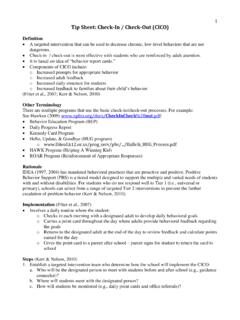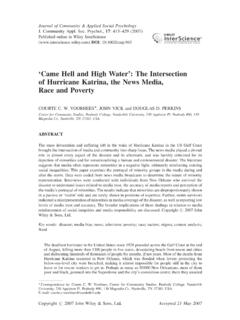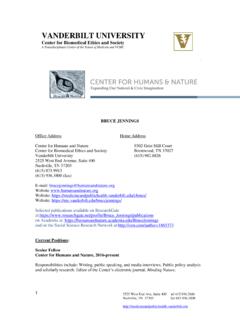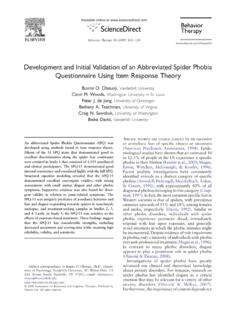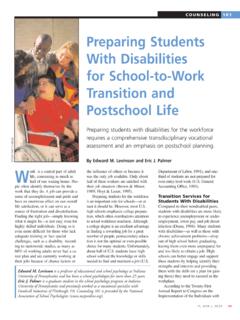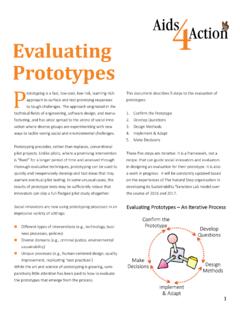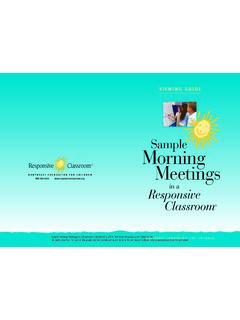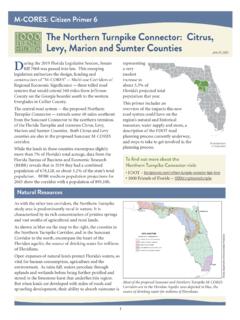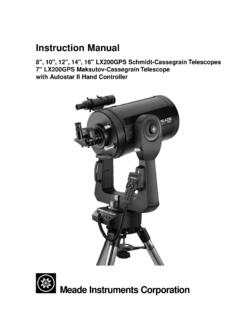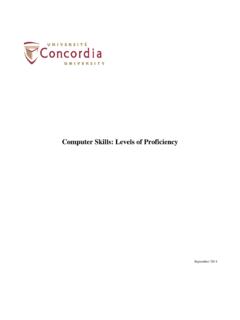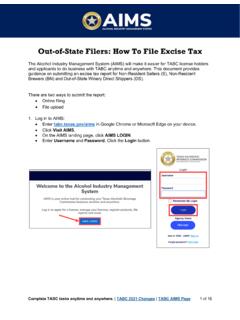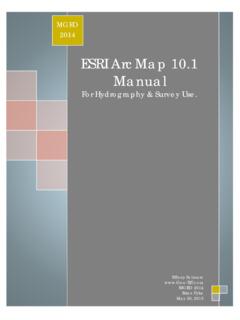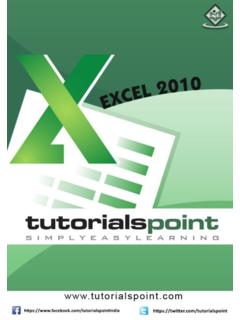Transcription of Reading Curriculum Based Measurement (Oral Reading …
1 Reading Curriculum Based Measurement (Oral Reading Fluency). Curriculum Based Measurement is a standardized and systematic method of formative assessment; CBM is an empirically validated method of progress monitoring with over 25 years of research on effectiveness of CBM. CBM has been linked to: Characteristics of CBM: Improved student academic outcomes Used to monitor student progress across More effective instruction an entire year Higher student achievement Probes are brief and easy to administer Increased student responsibility for Administered weekly or as benchmarks learning and administered the same way each time Relationship between CBM and high Each probe samples Curriculum for an stakes testing entire school year Better communication between parents Each probe is different, but each form and teachers assesses the same types of skills at same (Fuchs, Deno, Mirkin, 1984.)
2 Fuchs, Fuchs, level of difficulty & Hamlett, 1989, Good, Simmons, & CBM can be used to: Kameeuni, 2001) o Monitor student learning outcomes o Identify at-risk students o Evaluate intervention effectiveness o Guide instruction and cue instructional changes o Measure AYP. o Monitor annual goals and objectives (L. S. Fuchs & Fuchs, 2004; L. S. Fuchs, Fuchs, Hamlett, & Stecker, 1990; Hosp & Hosp, 2003). CBM Steps (adapted from Fuchs & Fuchs, 2005; Hosp, Hosp, & Howell, 2007). Step 1: Determine Reading CBM task for progress monitoring Step 2: Identify level of material Step 3: Administer and score Step 4: Graph scores Step 5: Set ambitious goals Step 6: Apply data decision rules Step 1: Determine Reading CBM task for progress monitoring (adapted from Hosp, Hosp, & Howell, 2007).
3 Grade Reading Task Description Kindergarten Letter Sound Fluency Students identify the sounds each letter makes when shown a list (LSF) of letters 1 Word Identification Students read a list of common words Fluency (WIF). Oral Reading Fluency Students read passages and words read correctly are counted (ORF). 2 ORF. 3 ORF. 4 and higher Mazes Students read a passage with blanks in place of words removed from the passage and choose a word to fill in the blanks. Words replaced correctly are counted. Note this tip sheet will focus on oral Reading fluency (ORF) because it is the most common Reading CBM assessment used. For details on using early Reading or maze CBM, see Hosp, Hosp, & Howell (2007).
4 Step 2: Identify level of material (Capizzi & Barton-Arwood, 2009). 1) Administer ORF probes written at student's current grade level 2) If there is a concern that a student is not Reading at grade level: a. If student reads less than 10 words in one minute, use word identification fluency b. If student reads 10 50 words correct in one minute use passages at the next lower level c. If student reads more than 50 words correct in one minute, move to the next higher level, not to exceed the student's current grade level d. Once you have determined the correct grade level of probes, use the same level for the entire year Step 3: Consistently administer and score 1) Obtain ORF CBM materials (adapted from Hosp et al.
5 , 2007). a) ORF passages (see below for resources to find passages). a. 2 copies of each passage (one for student & one for teacher to mark errors). b. Each passage should contain at least 200 words, be different but equivalent in grade level/difficulty, and represent the Reading skills that are expected by the end of the school year b) Stop watch or countdown timer c) Directions to administer the probes d) A graph to plot the data 2) Administer with individual students a) Administer 3 equivalent probes the first time in one session (recommended) or across days b) The median score will be first data point on graph 3) Use the same directions for each administration.
6 There are multiple versions of ORF. directions. Select one and consistently use it for each administration across the school year. The following script is one option (Hosp et al., 2007; p. 37): Give the student a copy of the Reading passage. Hold the teacher's version where the student cannot see what the teacher is writing ( , put it on a clip board). Say, I would like for you to read this story aloud for me. Please start here (point to the first word on the student's copy) and read aloud. This is not a race. Try each word. If you come to a word that you do not know, you may skip it and go to the next word. You may start when I say Begin.' You may stop when I say Stop Reading .
7 '. Do you have any questions? Set the timer for 1 minute. Follow the teacher's copy and make an X on any words read incorrectly. At the end of 1 minute, say, Stop Reading mark the last work the student read with a slash (/). 4) Scoring (Hosp et al., 2007). a) Count the total number of words attempted. Count the errors. Subtract the errors from the total number of words attempted to get words read correctly score (WRC). b) If a student finishes in less than one minute, note the number of seconds and use this formula: number of words read correctly divided by number of seconds to read the passage X 60. c) To score as correct Words read correctly within context of sentence.
8 Repetitions Self-correction Dialect Inserted words are not scored as correct or incorrect d) To score as incorrect Mispronunciations Word substitutions Omissions Hesitations for more than 3 seconds Reversals e) Other scoring Hyphenated words are counted as two words Abbreviations and numbers are counted as words and must be read correctly Do not count a skipped row as errors Do not correct a student when a word is misread Step 4: Graph scores (for progress monitoring purposes) (Fuchs & Fuchs, 2005). Two options: 1) Paper and pencil graphs a) Vertical axis - include the range of scores of all students in the class from zero to the highest score. Horizontal axis - include the number of weeks of instruction, allowing for data to be entered one to two times per week b) Make a template of the above and one copy for each student 2) chart Dog ( ): Web- Based data storage and management 3) Commercial CBM materials (see below under Premade CBM Materials).
9 Step 5: Set ambitious goals (Hosp et al., 2007). There are several options in goal setting: 1) Using benchmarks: Using the Reading CBM Benchmarks table below. Determine the end of year benchmark (performance level), which is the spring score at the 50th percentile. Graph the three baseline scores and the end of year benchmark. Draw a goal line on the graph from the median baseline score to the end of year performance goal. Grade Percentile Norms for Words Read Correctly (WRC). (AIMsweb, 2006). Fall Winter Spring 1 90% 49 78 106. 75% 22 46 80. 50% 8 23 52. 25% 2 13 38. 10% 0 6 15. 2 90% 103 129 143. 75% 79 103 118. 50% 54 77 92. 25% 27 52 68. 10% 14 25 42.
10 3 90% 130 148 163. 75% 103 124 139. 50% 77 96 110. 25% 49 67 82. 10% 30 41 52. 4 90% 149 168 184. 75% 123 141 155. 50% 99 114 126. 25% 73 89 100. 10% 48 62 73. 5 90% 169 183 198. 75% 142 158 171. 50% 112 128 141. 25% 85 99 109. 10% 60 73 82. 6 90% 182 199 211. 75% 158 171 183. 50% 131 144 155. 25% 101 114 126. 10% 70 83 94. 7 90% 186 197 209. 75% 160 169 183. 50% 131 140 153. 25% 103 112 124. 10% 81 87 96. 8 90% 185 193 201. 75% 162 170 180. 50% 138 146 155. 25% 107 115 127. 10% 77 83 94. 2) Using norms: Using the ORF CBM Weekly Growth Rates table and the formula to calculate the end of year goal. Graph the three baseline scores and the end of year goal.

